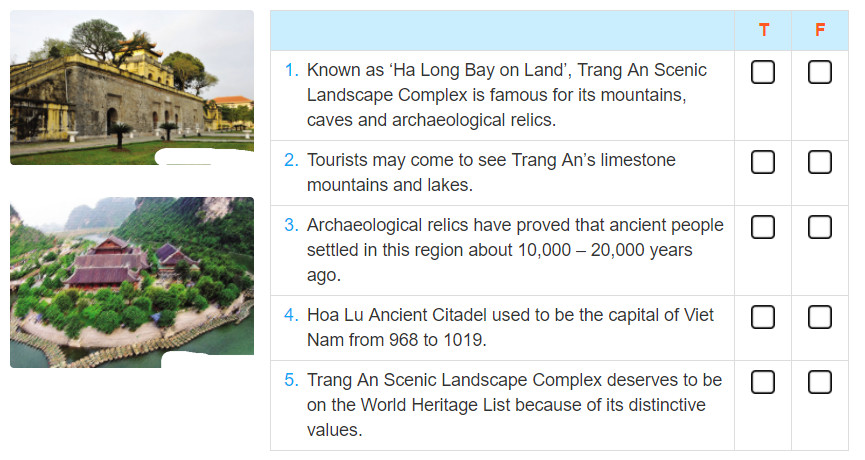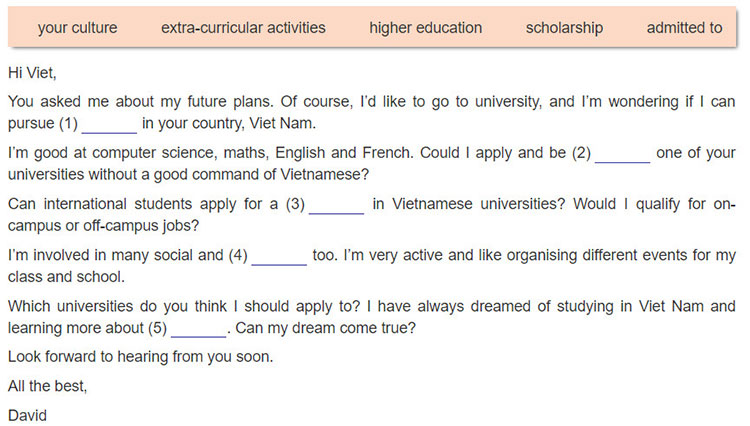Review 3 lớp 11 - Skills
Bài học Review 3 lớp 11 mới phần Skills hệ thống kiến thức đã học trong các Unit 6, 7, 8 giúp các em ôn luyện các kĩ năng đọc hiểu, nói, nghe hiểu và viết. Mời các em cùng tham khảo!
Mục lục nội dung

Review 3 lớp 11 - Skills
1. Reading
The risk of sea-level rise (Mối đe dọa của việc nước biển dâng)
1.1. Task 1 Review 3 lớp 11
Read the text about the risk of sea-level rise. (Đọc bài nói về nguy cơ dâng nước biển.)
More than 20 coastal cities in Viet Nam are directly affected by rising sea levels. This can endanger water supply in all coastal cities and threaten the life of millions of people.
Viet Nam’s Me Kong Delta, one of Asia's most fertile rice-growing regions and home to approximately 20 million people, faces the risk of fast sea-level rise. Sea-level rise could flood more than 80 percent of the Me Kong Delta, and rice production may drop by about 2.6 million tonnes per year.
Tạm dịch:
Hơn 20 thành phố vùng bờ biển của Việt Nam đang chịu ảnh hưởng trực tiếp bởi mực nước biển đang dâng cao. Điều này sẽ nguy hại đến nguồn cung cấp nước cho tất cả các thành phố vùng bờ biển và đe dọa mạng sống của hàng triệu người.
Vùng châu thổ sông Mê Kông của Việt Nam, một trong những vùng trồng lúa màu mỡ nhất châu Á và là nơi sinh sống của khoảng 20 triệu người đang đối mặt với nguy cơ mực nước biển dâng nhanh. Việc dâng mực nước biển có thể gây ngập lụt đến hơn 80% vùng châu thổ sông Mê Kông, và việc sản xuất lúa ở đây có thể tụt xuống khoảng 2.6 triệu tấn mỗi năm.
Bên cạnh đó hệ sinh thái tự nhiên và các hoạt động kinh tế như đánh bắt cá và du lịch có thể gây ra sự xói mòn bờ sông, bờ biển mà có thể dẫn đến mất đất.
Vấn đề nước biển dâng là vấn đề toàn cầu. Mọi người cần hiểu những nguy hại đối với đời sống ở những vùng bờ biển và chuẩn bị giải quyết những vấn đề này.
1.2. Task 2 Review 3 lớp 11
Read the text and answer the questions. (Đọc đoạn văn và trả lời câu hỏi)
1. Why are rising sea levels a direct threat to Viet Nam? (Tại sao nước biển dâng đe dọa đến Việt Nam?)
2. How is the Mekong Delta described? (Đồng bằn sông Mê Kong được miêu tả thế nào?)
3. What may happen as a result of sea-level rise in the MeKong Delta? (Điều gì có thể xảy ra do mực nước biển dâng ở đồng bằng sông Mê Kong?)
4. How can natural ecosystems and economic activities be affected? (Hệ sinh thái tự nhiên và hoạt động kinh tế bị ảnh hưởng như thế nào?)
5. What can storms and rising sea levels lead to? (Bão và nước biển dâng có thể dẫn đến điều gì?)
Guide to answer
1. Because more than 20 cities are directly affected. Rising sea levels can endanger water supply in these cities threaten the life of millions of people. (Vì sẽ có hơn 20 thành phố sẽ bị ảnh hưởng trực tiếp. Nước biển dâng có thể phá hủy nguồn nước ở các thành phố đe dọa cuộc sống của hàng triệu người dân.)
2. It is described as one of Asia's most fertile rice-growing regions and home to approximately 20 million people. (Nó được miêu tả như là vựa lúa màu mỡ nhất châu Á và có khoảng xấp xỉ 20 triệu người.)
3. More than 80 percent of the Me Kong Delta could be flooded. Rice production may drop by about 2.6 million tonnes per year. (Hơn 80% đồng bằng sông Mê Kong sẽ bị ngập lụt. Việc sản xuất lúa gạo có thể sụt giảm khoảng 2.6 triệu tấn mỗi năm.)
4. Natural ecosystems and economic activites such as fisheries and tourism can be disrupted. (Hệ sinh thái tự nhiên và các hoạt động kinh tế như đánh bắt thuỷ sản và du lịch có thể bị gián đoạn)
5. They can lead to erosion of river banks and beaches, and loss of land. (Chúng có thể dẫn đến sói mòn các bờ sông và biển, bị mất đất.)
2. Speaking
A heritage tour (Một chuyến đi thăm di sản)
Work with a partner. Choose a heritage site and talk about what you can do and see there. Use the information in Unit 8, if necessary. (Làm việc với bạn bên cạnh. Chọn một miền đất di sản và nói về những điều em có thể thấy và làm ở đó, sử dụng thông tin ở bài 8 nếu cần.)
Example
Student A: Let’s talk about our heritage tour. Which site do you think we should visit?
Student B: How about going to Trang An Scenic Landscape Complex?
Student A: What can we see there?
Student B: There are many beautiful caves and unique pagodas.
Student A: Well,...
Tạm dịch:
Học sinh A: Hãy nói chuyện về chuyến đi du lịch di sản văn hóa của chúng ta. Bạn nghĩ địa danh nào nên đến thăm?
Học sinh B: Làm thế nào về Khu danh thắng Tràng An?
Học sinh A: Chúng ta có thể nhìn thấy gì ở đó?
Học sinh B: Có rất nhiều hang động đẹp và chùa độc đáo.
Học sinh A: Vâng, ...
3. Listening
Trang An Scenic Landscape Complex (Quần thể danh lam thắng cảnh Tràng An)
Listen to the recording about Trang An Scenic Landscape Comlex. Decide whether the following statements are truc (T) or false (F) according to the speaker. (Nghe đoạn ghi âm nói về Quần thể danh lam thắng cảnh Tràng An và nói xem những lời phát biểu dưới đây đúng (T) hay sai (F) theo người nói trong đoạn ghi âm.)
Click to listen

Guide to answer
1 – T 2 – F 3 – T 4 – F 5 – T
Audio Script:
Known as "Ha Long Bay on land", Trang An Scenic Landscape Complex is famous fat its mountains, caves and archaeological relics. It includes Trang An Eco-tourist Site, Tan Coc - Bich Dong Landscape and Hoa Lu Ancient Citadel.
Visitors come to Trang An to admire its diverse flora and fauna, beautiful caves and unique pagodas. Achaeological relics have proved that humans in this region date back to about 10,000 - 20.000 years ago. Ancient people took advantage of the rich land, settled down in the area and developed their culture.
Kings from the Dinh, Le and Ly Dynasties set up the capital in Hoa Lu Ancient Citadel from 968 to 1009. After King Ly Thai To moved the capital from Hoa Lu to Ha Noi in 1010. the citadel remained known as the ancient capital of Viet Nam.
Having unique natural and cultural values. Trang An scenic Landsepae Complex deserves its place on the UNESCO's World Heritage List.
Tạm dịch:
Được biết đến với cái tên "Vịnh Hạ Long trên đất liền", Khu danh thắng Tràng An nổi tiếng với những ngọn núi, hang động và di tích khảo cổ. Bao gồm Khu du lịch sinh thái Tràng An, cảnh Tam Cốc - Bích Động và thành cổ Hoa Lư.
Du khách đến Tràng An để chiêm ngưỡng động thực vật đa dạng, những hang động đẹp và những ngôi chùa độc đáo. Các di tích khảo cổ học đã chứng minh rằng con người ở khu vực này đã trở lại từ khoảng 10.000 - 20.000 năm trước. Người cổ đại đã dùng đất đai phong phú, định cư trong khu vực và phát triển văn hóa của họ.
Các vị vua từ các triều Đình, Lê và Lý đã thành lập thành Hoa Lư từ năm 968 đến năm 1009. Sau khi vua Lý Thái Tổ di chuyển thành Hoa Lư sang Hà Nội năm 1010. Thành trì vẫn được biết đến như là thành cổ của Việt Nam.
Có những giá trị tự nhiên và văn hoá độc đáo. Tổ hợp phong cảnh Tràng An xứng đáng nằm trong Danh sách Di sản Thế giới của UNESCO.
4. Writing
4.1. Task 5 Review 3 lớp 11
Read and complete David’s letter, using the words in the box. (Đọc và hoàn thành bức thư của David, dùng từ cho trong khung.)

Guide to answer
1. higher education
2. admitted to
3. scholarship
4. extra- currcular activities
5. your culture
Tạm dịch:
Chào Việt,
Bạn hỏi tôi về kế hoạch tương lai của tôi. Tất nhiên, tôi muốn lên đại học, và tôi tự hỏi liệu tôi có thể theo được giáo dục đại học ở nước bạn, Việt Nam.
Tôi giỏi về khoa học máy tính, toán, tiếng Anh và tiếng Pháp. Tôi có thể xin và được nhận vào một trong những trường đại học của bạn mà không có một sự kiểm soát chặt chẽ ở Việt Nam?
Sinh viên quốc tế có thể nộp đơn xin học bổng tại các trường đại học Việt Nam không? Liệu tôi có đủ điều kiện để được nhận vào học tại trường trường hoặc ngoài trường không?
Tôi tham gia nhiều hoạt động xã hội và các hoạt động ngoại khóa nữa. Tôi rất năng động và thích tổ chức các sự kiện khác nhau cho lớp học và trường học của tôi.
Bạn nghĩ tôi nên nộp đơn vào trường đại học nào? Tôi luôn mơ ước học tập ở Việt Nam và học hỏi thêm về nền văn hoá của bạn. Giấc mơ của tôi có thành hiện thực không?
Hi vọng nhận được phản hồi sớm từ bạn.
Trân trọng,
David
4.2. Task 6 Review 3 lớp 11
Write a similar letter to the letter in 5. (Hãy viết một bức thư tương tự như ở bài tập 5.)
Guide to answer
Hi Lisa,
You asked me about my future plans. Of course, I'd like to go to university, and I’m wondering if I can pursue higher education in your country, the USA.
I'm good at English, maths, science and geography, now. I'm working hard to get high scores in the test of English as a foreign language. Would high scores on this test help me obtain a good scholarship? Can international studens like me apply for financial aid in us colleges? Would I qualify for on-campus or off-campus jobs?
I'm invovled in many social and extra-curricular activities too. I'm very active and like organising different events for my class and school.
Which universities do you think I should apply to? I have always dreamed of studying at a US college and graduating with highest honours. Can my dream come true?
Look forward to hearing from you soon.
Best wishes,
Ha
Tạm dịch:
Chào Lisa,
Bạn hỏi tôi về kế hoạch tương lai của tôi. Tất nhiên, tôi muốn lên đại học, và tôi tự hỏi liệu tôi có thể theo đuổi nền giáo dục đại học ở nước bạn, Mỹ hay không.
Tôi giỏi tiếng Anh, toán, khoa học và địa lý. Tôi đang làm việc chăm chỉ để có được điểm số cao trong bài thi tiếng Anh. Liệu điểm số cao trong kỳ thi này sẽ giúp tôi có được một suất học bổng tốt? Các sinh viên quốc tế như tôi có thể xin trợ cấp tài chính ở trường đại học không? Liệu tôi có đủ điều kiện để học theo học tại trường hoặc ngoài trường không?
Tôi cũng tham gia nhiều hoạt động xã hội và ngoại khóa. Tôi rất năng động và thích tổ chức các sự kiện khác nhau cho lớp học và trường học của tôi.
Bạn nghĩ trường đại học nào tôi nên nộp đơn? Tôi luôn mơ ước học tại một trường đại học Hoa Kỳ và tốt nghiệp với danh dự cao. Giấc mơ của tôi có thành hiện thực không?
Hi vọng nhận được phản hồi sớm.
Gửi lời chúc tốt nhất,
Hà
5. Practice Task 1
Read the following passage and mark the letter A, B, C, or D on your answer sheet to indicate the correct answer to each of the questions.
Centuries ago, man discovered that removing moisture from food helped to preserve it, and that the easiest way to do this was to expose the food to sun and wind. In this way the North American Indians produced pemmican (dried meat ground into powder and made into cakes), the Scandinavians made stockfish and the Arabs dried dates and apricots.
All foods contain water - cabbage and other leaf vegetables contain as much as 93% water, potatoes and other root vegetables 80%, lean meat 75% and fish anything from 80% to 60% depending on how fatty it is. If this water is removed, the activity of the bacteria which cause food to go bad is checked.
Fruit is sun-dried in Asia Minor, Greece, Spain and other Mediterranean countries, and also in California, South Africa and Australia. The methods used vary, but in general the fruit is spread out on trays in drying yards in the hot sun. In order to prevent darkening, pears, peaches and apricots are exposed to the fumes of burning sulphur before drying. Plums for making prunes, and certain varieties of grapes for making raisins and currants, are dipped in an alkaline solution in order to crack the skins of the fruit slightly and remove their wax coating, so increasing the rate of drying.
Nowadays most foods are dried mechanically; the conventional method of such dehydration is to put food in chambers through which hot air is blown at temperatures of about 110°C at entry to about 45°C at exit. This is the usual method for drying such things as vegetables, minced meat, and fish.
Liquids such as milk, coffee, tea, soups and eggs may be dried by pouring them over a heated horizontal steel cylinder or by spraying them into a chamber through which a current of hot air passes. In the first case, the dried material is scraped off the roller as a thin film which is then broken up into small, though still relatively coarse flakes. In the second process it falls to the bottom of the chamber as a fine powder. Where recognizable pieces of meat and vegetables are required, as in soup, the ingredients are dried separately and then mixed.
Dried foods take up less room and weigh less than the same food packed in cans or frozen, and they do not need to be stored in special conditions. For these reasons they are invaluable to climbers, explorers and soldiers in battle, who have little storage space. They are also popular with housewives because it takes so little time to cook them.
Question 1: What is the main idea of the passage?
A. Advantages of dried foods.
B. Water: the main component of food.
C. Mechanization of drying foods.
D. Different methods of drying foods.
Question 2: The phrase “do this” in the first paragraph mostly means ______.
A. expose foods to sun and wind B. remove moisture from foods
C. produce pemmican D. moisten foods
Question 3: The word “checked” in the second paragraph is closest in meaning to _____.
A. reduced considerably B. put a tick
C. examined carefully D. motivated to develop
Question 4: In the process of drying certain kinds of fruits, sulphur fumes help ______.
A. remove their wax coating B. kill off bacteria
C. maintain their color D. crack their skin
Question 5: Nowadays the common method for drying vegetables and minced meat is ______.
A. spreading them out on trays in drying yards
B. dipping them in an alkaline solution
C. putting them in chambers and blowing hot air through
D. pouring them over a heated horizontal steel cylinder
Question 6: What does the word “which” in the fourth paragraph refer to?
A. Vegetables B. Foods C. Things D. Chambers
Question 7: The final product of the process of drying liquids that uses the first method will be ______.
A. small flakes B. fine powder C. dried soup D. recognizable pieces
6. Practice Task 2
Mark the letter A, B, C, or D to indicate the sentence that best combines each pair of sentences in the following questions.
Question 1. Marie prepared her homework carefully. She could answer all the questions and got good marks.
A. Although she prepared her homework carefully, Marie could not answer all the questions and got good marks.
B. Having prepared her homework carefully, Marie could answer all the questions and got good marks.
C. If she had prepared her homework carefully, Marie could have answered all the questions and got good marks.
D. It was because of her careful preparation for the homework, Marie couldn't answer all the questions and got good marks.
Question 2. We have been trying to learn English for years. We haven't succeeded yet.
A. Although we have been trying to learn English for years, we haven't succeeded yet.
B. After we've been trying to learn English for years, we have succeeded.
C. We haven't succeeded yet since we have been trying to learn English for years.
D. We have been trying to learn English for years, so we haven't succeeded yet.
Question 3. The teacher was giving the lesson. The lights went out.
A. The lights went out as soon as the teacher started giving the lesson.
B. If the teacher had been giving the lesson, the lights wouldn't have gone out.
C. The teacher was giving the lesson, so the lights went out.
D. While the teacher was giving the lesson, the lights went out.
Question 4. Our school started building a new canteen in June. They are still building it now.
A. Our school have started building a new canteen from June till now.
B. Our school have been building a new canteen since June.
C. Our school have built a new canteen now since starting in June.
D. Our school are building the new canteen which started in June.
7. Conclusion
Kết thúc bài học, các em cần luyện tập các kĩ năng sau:
- Luyện đọc và trả lời câu hỏi
- Luyện tập tạo đoạn hội thoại và tập nói
- Luyện nghe và chọn đáp án đúng
- Luyện viết một lá thư nói về dự định trong tương lai
Tham khảo thêm
- doc Review 3 lớp 11 - Language

